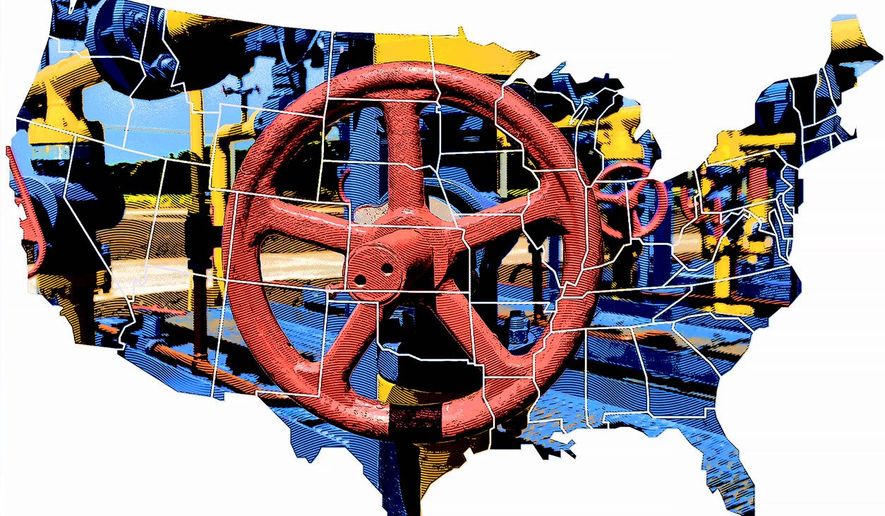OPINION:
A mentor of mine, the late Alaska Gov. and Interior Secretary Wally Hickel used to say, “the color of the environment isn’t just green — it’s real.” Whatever the intention is of those who fight new energy transportation projects, the reality is that we still need to move energy around the world.
Somehow that reality hasn’t slowed the number of pipeline fights raging across our continent.
When I was in high school and college, the national battle royal was whether we should build the trans-Alaska oil pipeline to bring oil from America’s largest onshore field to market. A generation later, we’ve seen more battles royal over building pipelines. Perhaps the loudest protests, some still raging in the courts, are over the proposed Keystone XL Pipeline from Canada into the United States.
I’d like to think we’ve learned a thing or two in a generation:
We’ve found new oil and gas supplies, and the fracking revolution has made “energy dominance” a viable policy for the United States. We are on the verge of becoming a net energy exporter, with more oil produced here at home and proposed natural gas export projects leading the way to help other nations switch to cleaner fuels abroad.
We’ve made carbon emissions a “front and center” consideration, at the same time, and sometimes the battle over pipeline construction in the United States and Canada is a surrogate for arguments some individuals have made to leave all new oil and gas “in the ground” as a way to somehow steer us to alternative energy supplies. While alternative energy sources continue to be perfected, natural gas is increasingly functions as a “bridge fuel” to get power generation — mostly coming from coal around the world — on a cleaner track.
We’ve also learned that consuming energy from abroad has difficult consequences. Global overreliance on fuel from the Middle East and Russia has had consequences in instability and massive transfers of wealth from one part of the world to another. Even as we reach for new sources of energy, it’s good policy to acquire the oil and gas we do consume from safer sources in North America. It keeps our money home, and maybe our soldiers home as well.
The bottom line is pipelines are still a necessary part of that mix.
We’ve certainly improved both pipeline safety, inherently, and in the last decade we’ve dramatically expanded safety regulation at the federal level. Since 2005, when the Bush administration and Congress created the Pipeline and Hazardous Materials Safety Administration under the U.S. Department of Transportation, the number of reported pipeline incidents — as well as the total number of hazardous substance releases — has decreased by more than 50 percent. The PHMSA reported last year that pipelines now safely deliver more than 99.999 percent of all shipments, the highest safety percentage of any transportation system.
A large part of the Keystone XL battle has been fought through the adjudication of a permit to allow the pipeline to cross the U.S.-Canada border. That policy, implemented in the 1960s by President Lyndon Johnson, was intended more to protect foreign policy interests rather than environmental considerations. We have a string of federal and state agencies whose job is to ensure pipelines are constructed to the highest standards, routed on stable ground, that construction and operation meet water and air quality standards, that spill prevention is paramount in design, and preparation for a clean-up, God forbid, is in place if a pipeline does spring a leak.
Beginning with the George W. Bush administration, and continuing through eight years of Barack Obama, the State Department struggled with the Keystone decision, and whether it — a foreign affairs agency — needed to take responsibility for deciding whether any or all environmental impacts of a pipeline were appropriate. Border crossings, according to the latest Trump executive orders on the subject, will be determined on foreign policy concerns — at the White House, rather than over in Foggy Bottom at State.
America’s energy policy is not contradictory. Yes, we are working to improve alternative energy technology, economics and implementation across the globe. But given that natural gas is a clean-burning bridge fuel, and it is better to consume energy produced here at home, we must continue to improve our oil and gas pipeline networks. For now, America’s doing the right thing to facilitate safe pipeline construction and operation. It does much for the environment, our security, our economy.
• Mead Treadwell, who served as Alaska’s lieutenant governor and as deputy commissioner of Alaska’s Department of Environmental Conservation, helped write Alaska and U.S. oil spill prevention laws after the 1989 Exxon Valdez oil spill.




Please read our comment policy before commenting.